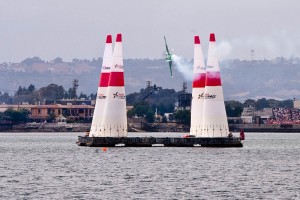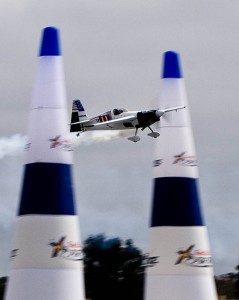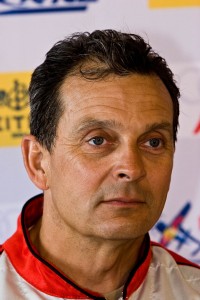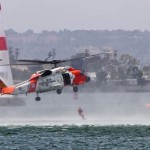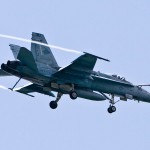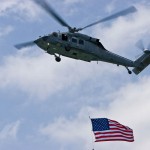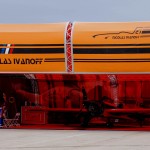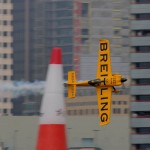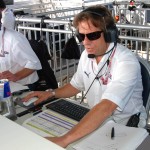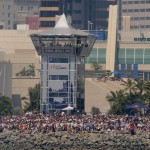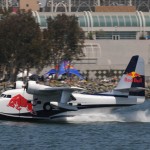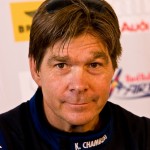By Bob Shane
The second round of the 2008 Red Bull Air Race World Series, featuring 12 of the world’s top pilots, took to the air May 3-4. The white racecourse pylons erected in San Diego Bay, rising above the water, were in sharp contrast with the cosmopolitan skyline of downtown San Diego, Calif. The two-day show attracted more than 120,000 air race fans.
Reminiscent of September’s Red Bull Race in San Diego, it was déjà vu as Paul Bonhomme, the Brit, and Mike Mangold, the Yank, battled head-to-head for the top points standing in the 2008 Air Race World Series. But when the spray from the bay had settled, Bonhomme had again flown past the competition, garnering not only fist place in the San Diego Race, but holding on as the points leader in the 2008 race season (Bonhomme also won the first race in Abu Dhabi, United Arab Emirates, on April 11).
Bonhomme’s winning time in the San Diego race was 1 minute, 18.01 seconds. Mangold finished second with a time of 1 minute, 19.24 seconds.
“I’m very pleased to take the win”, said Bonhomme, who also won the race in “America’s Finest City” last year. “It’s a challenging track here in San Diego. You have to be consistent in every session all the time. Today we saw some tight flying, and I had to work very hard to get this spot.”
Mangold demonstrated his resilience in San Diego, bouncing back from a third place position three weeks ago to a close second. He worked with his technician overnight to remove about three pounds of weight from his plane, and put in a fantastic run to beat second-year sensation Hannes Arch in the semifinals, clocking 1:17.74. Bonhomme was only marginally faster in his semifinal against the American, Kirby Chambliss, who finished third.
“I’m pleased to be on the podium, considering the circumstances, but annoyed that I can’t get my plane to go any faster,” said Mangold, the local American hero. “I think the conditions were ideal in the semifinal. Paul had his fastest time there too. I was pleased with that run. I just got a little bit too wild in the final, a bit too sloppy. Paul’s got a great plane and he’s a great pilot.”
The Red Bull Air Race World Series once again coincided with the start of San Diego’s annual Fleet Week, which pays tribute to the military. On Saturday morning, May 3, the military launched the air and sea parade. The Navy sailed five warships, a frigate, two destroyers and two amphibious ships down “The Big Bay.” A pair of tall ships was part of the display. The Navy and Coast Guard each staged a simulated air/sea helicopter rescue. The show included flybys of the Navy’s F-18 Super Hornet, other Navy aircraft and vintage planes from WWII. The Red Bull Air Force skydiving team performed precision parachuting.
New on the race circuit this year was an appearance by a Grumman Albatross sporting the Red Bull logo. This immaculately restored vintage seaplane, built in the ’50s, serves as a flying billboard for the company as well as an airborne platform for photographers recording Red Bull events. Designated an HU-16E, the amphibious aircraft made a graceful touch-and-go water landing in San Diego Bay, as thousands of air race fans looked on in amazement.
The air race series, now in its fourth season, continues to evolve. This year’s significant change was the streamlining of the racing format, allowing all 12 pilots to compete on race day. Qualifying day now is the day before the race. Each pilot competes in two qualifying sessions; the best results determine the lineup on race day, with the slowest pilot flying first. Race day opens with ‘point one,’ which is then followed by the ‘super eights.’ The last four pilots in qualifying go through to the point one session to battle it out for one crucial World Series point and an overall ninth place position in the race. The fastest eight pilots in qualifying advance to the super eights to compete for a place in the semifinals. Racing straight after each other, the pilots go all out for the fastest time and least number of penalties in order to achieve the best position for the semifinals.
The fastest four from the super eights advance to the semifinals. Timing and skill are crucial, as the fastest pilot from the top four in the super eights will gain the advantage of racing against the slowest pilot. The second fastest pilot will take on the third fastest. Competing in knockout heats, two pilots battle each other as they race individually against the clock. In all flying sessions (except training), pilots fly in reverse order, with the slowest pilot from the previous session going first. The two slower pilots from each of the semifinal heats race for third place in the ‘third place fly-off.’ The final is a showdown between the faster pilots from each of the semifinal heats.

L to R: Mike Mangold, Paul Bonhomme and Kirby Chambliss joke with each other on the podium. Spectators could follow the race action on numerous television and jumbotron screens located throughout the venue.
The new race format better ensures non-stop action and enhances safety. Safety is paramount in the Red Bull Air Race.
“This improved race format fulfils the new safety requirements that were discovered throughout the 2007 season. Pilots will now fly a maximum of three flights per day to counteract the fatigue,” says Heinz Moeller, head of aviation.
The race format in 2007 led to some of the pilots flying four times throughout the course of the day, which can be extremely demanding on them.
“The most exciting thing about this format is that the crowds now get the chance to see all pilots perform on race day,” Moeller added.
With the new race season came new hangars and a new look for pit lane, with 12 individual hangars constructed from aluminium and fireproof polyvinyl chloride. They can be set up in three days and dismantled in two. In conformity with Red Bull’s profound attention to detail, the pilots’ flight suits, helmets, aircraft and hangars are all coordinated this year. The larger hangars provide more space and the brilliant colors are attractive to look at.
This year the race aircraft staged out of the Naval Air Station, North Island. Thousands of Red Bull Air Race World Series fans crowded onto the base on Saturday morning for the traditional Public Pit Lane Walk. Many had come especially to meet defending champion Mike Mangold and to get a closer look at his Edge 540 that takes him up to 230 mph at forces of up to 10 G’s through the obstacle course set up just 10 meters above the water.
“I don’t know how you all got on base—are we still safe?” said Mangold, referring to the security at the U.S. Naval Station, with a laugh to the several hundreds of fans lined up across the tarmac outside his hangar. “This is really great,” said Mangold, clearly enjoying his star status at the race not far from his home in Victorville, Calif. “I appreciate all the people coming out. It’s fantastic that they’re all rooting for me.”
Mangold finished first and third in Friday’s two training sessions—only fractions of a second behind the Austrian, Arch, and Chambliss in the final training session. But more importantly for Mangold, he was ahead of his great rival, championship leader Bonhomme of Britain, in both runs on Friday.
“I really love the way Mike races and flies,” said Mangold fan James Branesky, who traveled from Fort Worth, Texas, to see the race and cheer his favorite flyer. “He’s always aggressive, a true ex-combat pilot, and he always says in his interviews, ‘I’m here to win the race.’ I like that. Plus, he’s American.”
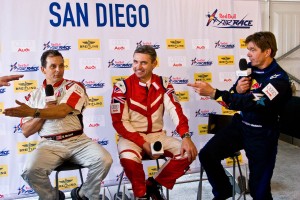
L to R: Top three finishers Mike Mangold, 2nd; Paul Bonhomme, 1st; and Kirby Chambliss, 3rd; share a light moment at the after race press conference.
Branesky had already been waiting for nearly a half hour to say “hello” to Mangold—and urge him to make some T-shirts and caps for sale because all his friends would love to buy them. He didn’t mind the long wait, even though he had at least another half hour in front of him on a bright, sunny day in Southern California. He said that even though he could appreciate the beauty of Bonhomme’s smooth style, he would always remain a Mangold fan. “I just want to wish him luck and tell him we’re pulling for him.”
C.J. Vidrine was also waiting to meet Mangold. She said she turned into a fan of the race a year ago and spoke knowledgeably about the intricacies of the high-speed sport.
“I saw the race at Monument Valley on television; since then I’ve been hooked,” said Vidrine.
By Saturday, the 20,000 tickets for the race were nearly all sold out and long lines of spectators headed for the shoreline of San Diego Bay to watch Saturday’s qualifying sessions.
The Red Bull race tower, the nerve center of the air race, also reflected some innovations this year. The 2008 race tower is a new design with fixed walls. The ground floor personnel control an estimated 450 radios handed out during the race. The radios allow members of the air race crew, located in the compound and at other stations, to stay in constant communication. An audio engineer, the show call assistant and the screen director share the first floor of the tower. On the second floor is the aqua events team, which supervises the water operations during the race. The third floor houses the group in charge of information systems, timing and speed tracking, as well as TV and international event production. On the top floor is the office of Frank Lischka, the show director for the race series, as well as the aviation manager and the race director. Nearly 50 people staff the race tower, all working to produce the most spectacular air race possible.
For additional race information, visit [http://www.redbullairrace.com].
- The Coast Guard conducted a demonstration of search and rescue techniques, including deploying a rescue swimmer.
- The Navy demonstrated the F/A-18C fighter as part of the Fleet Week observation.
- The Blackjacks of Helicopter Sea Combat Squadron 21 carried the U.S. flag for the opening ceremonies.
- Twelve aluminum framed hangars shelter the race planes from the elements and provide personalized eye-catching graphic designs, such as the one used by the French pilot Nicolas Ivanoff.
- The colors of Breitling, the official timekeeper and team partner with Red Bull, are highly visible on Nigel Lamb’s MXS race aircraft.
- Paul Bonhomme of Great Britain displays perfect technique rounding a pylon with the buildings of downtown San Diego in the background.
- The show director, Frank Lischka (left), manages the race activity from his office on the 4th floor of the race tower.
- The Red Bull race tower, located on the South Embarcadero peninsula, is the nerve center for the air race.
- Displaying the Red Bull logo, a Grumman Albatross demonstrated a water landing prior to the start of race activity.
- Austrian pilot Hannes Arch, last year’s rookie, finished in fourth place, flying his silver Edge 540.
- American Kirby Chambliss flew his Zivko Edge 540 to third place.












